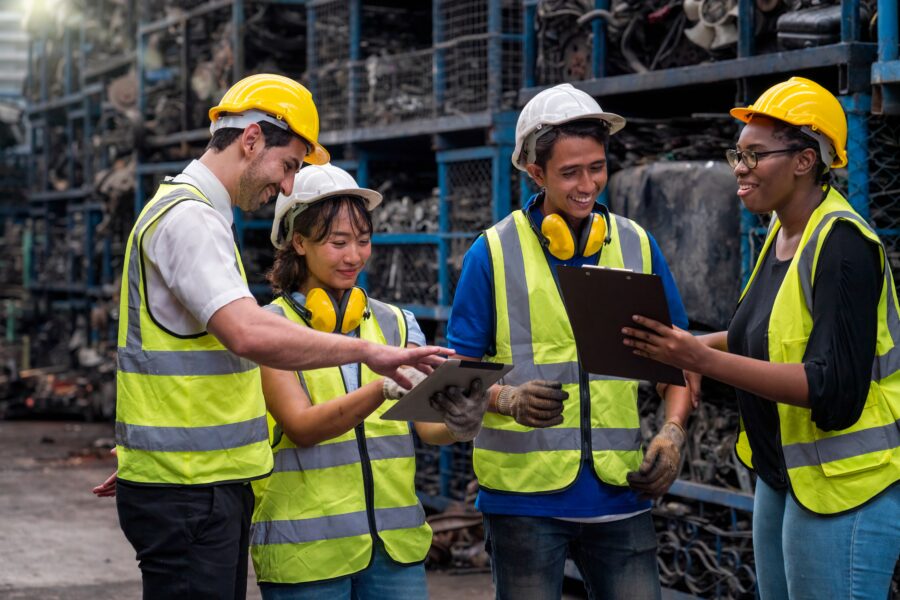The construction industry is facing unique workforce challenges. A perfect storm created by Covid, Brexit, IR35, an ageing workforce, and the cost-of-living crisis has seen the number of employees in the sector consistently fall over the past few years. This has resulted in a war for talent and a battle of retention.
There are several distinct challenges likely to be high on your agenda right now:
1. Attraction and retention
The attraction and retention challenge in construction has arisen from three key factors:
- The talent pool has dramatically reduced. In 2021, the number of self-employed workers in construction hit its lowest level for 18 years. And this hasn’t been matched by an increase in direct labour.
- The grass is greener. With the ‘great resignation’ hitting hard, the existing workforce is more likely to move to competitor organisations for better perceived pay, culture or benefits.
- A workforce nearing retirement. According to the CIOB, the number of employees above 60 is increasing more than any other age group in the sector. There’s also a lack of younger talent attracted to the industry, with the number of construction apprentices falling consistently since 2018.
For people professionals in the construction industry, culture is your secret weapon. It provides you with a unique identity that will differentiate you from your competitors in a decreasing pool of talent, and should be high priority for your leadership teams.
2. Equality, diversity, inclusion and belonging (EDIB)
From leadership to manual labour, the construction industry is not known for being a diverse or inclusive environment. This is backed up by data showing that women make up just 15% of the UK construction industry. This is whilst only 6% are from BAME backgrounds and just 6% are disabled. When it comes to those identifying as LGBTQ+, the numbers are tricky, as more than a third of LGBTQ+ admitted they hide or disguise their identity at work.
EDIB should be one of the top challenges you’re looking to address. But there’s a huge amount of work to be done. Improving your inclusivity to create a more diverse workforce will bring a wider pool of talent, different insights, new skills, and innovations into your business.
See how WorkBuzz helped HS2 improve diversity and inclusion in this video.
3. Health & safety and wellbeing
Every construction project comes with hazards for both workers and members of the public. But with a stretched workforce and increasing costs, health & safety and wellbeing measures can slip – leading to a rise in accidents and their associated financial impact. This is when employee engagement inevitably takes a hit.
People are part of your health & safety and wellbeing solution. You need to offer all employees an easy and confidential mechanism for flagging near misses or areas of concern. And, with mental health becoming an increasingly important topic in what is typically seen to be a ‘machoistic’ working environment, you should listen to your employees about what triggers are present in the workplace – with a view to avoiding or eradicating these causes in the long run. Stonbury, for example, created an employee listening strategy with WorkBuzz that resulted in a 75% decrease in RIDDOR incidents and a wider consideration for mental health, psychological safety, and inclusivity.
4. Communication
The construction workplace is constantly changing, with workers moving to different sites dependent on the needs of projects. This makes engaging employees more challenging. This is why conducting employee listening across your entire workforce – including all those self-employed or directly employed – is essential. It’s the only way you can consistently identify departments, teams or groups that have issues. And for employees to feel engaged in their roles, it’s vital that leadership teams communicate with all employees. This shows that they’re aware of issues, are addressing their needs, and are offering support.
Regular employee surveys are the best way to understand the consensus of your workforce – and to mark progression over time. Surveys can be digital or offline, and should be combined with other internal communications methods. For example, onsite meetings, newsletters or an employee intranet to create a seamless experience.
5. Commercial impact
Disengaged employees mean lower productivity levels, higher absenteeism and increased employee turnover. And these will have a knock-on effect on projects. And, with many large construction projects running over months, if not years, any delay impacts the bottom line.
Having a leadership team that acknowledges the power of employee engagement – and the positive financial impact it has – is essential. Combine this with data insights and defined employee KPIs and you can make powerful people decisions tailored to your business.
To give you an example, HS2 improved employee retention by 9% and made commercial savings of £2-£3m through its employee engagement collaboration with WorkBuzz – a real impact on its bottom line.
Why should you focus on employee engagement?
Employee engagement is a deep rational and emotional connection to your organisation and the work you do. It’s the outcome of a great employee experience, and starts during the recruitment process – before you even turn up for your first day.
Engagement is important because it unlocks the potential of each individual, their motivation, and maximises their discretionary effort. If they’re engaged enough to become advocates for your organisation, engagement can live on long after employees leave – which has a tangible impact on commercial outcomes for your business.
WorkBuzz offers a fast, simple and flexible employee engagement platform where you can gather real-time feedback from your people through regular employee listening. We also offer expert consultancy through our People Science team, so you can action the feedback in a way that drives positive change across your organisation.
Our team comes with a wealth of experience supporting large and small construction organisations, including HS2, Breedon Group, Stonbury and VolkerWessel.
If you’d like to listen to your workforce, understand concerns, act on areas of improvement and build a culture people thrive in, book a call with us today.
